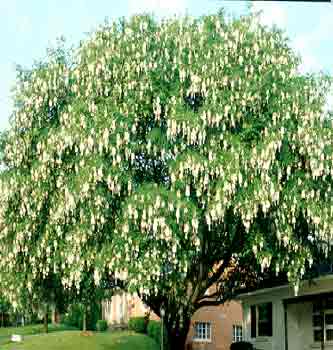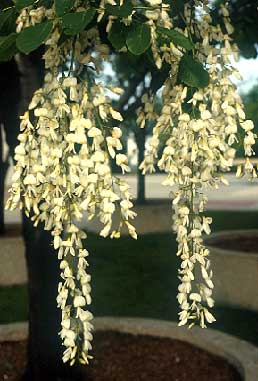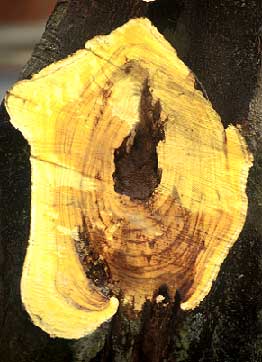 Yellowwood - Cladrastis kentukea
Yellowwood - Cladrastis kentukea
Pea Family (Fabaceae)
Yellowwood grows throughout Eastern Kentucky, but is most common along the Kentucky River palisades in the Bluegrass region. It produces clusters of white pea-like flowers in Spring. The Kentucky champion tree is in Cave Hill Cemetery in Jefferson County and is almost 80 feet tall.
 Culture: This tree prefers deep, moist, fertile, well-drained loam or moist sandy soil with a medium acid pH. It is hardy in Zones 4 to 8. It will tolerate both high pH and acidic soils. Although it flowers best in full sun, yellowwood does well growing in the forest.
Culture: This tree prefers deep, moist, fertile, well-drained loam or moist sandy soil with a medium acid pH. It is hardy in Zones 4 to 8. It will tolerate both high pH and acidic soils. Although it flowers best in full sun, yellowwood does well growing in the forest.
Yellowwood must be pruned to ensure good branch angles, or it will break apart. It should be pruned in summer, as the tree bleeds when pruned in spring. It should be grown with a single leader as far up as possible, and pruned to develop wide-spaced branches that have wide angles to the trunk, as well as a U-shaped crotch. If left unpruned, yellowwood will often fall apart after 30 to 40 years. It has thin bark that is easily damaged, however, so care should be taken when working around it.
- Native habitat: North Carolina to Kentucky and Tennessee. Scattered throughout Illinois, Indiana, Alabama, Mississippi, Arkansas, Missouri and Oklahoma.
- Growth habit: Low-branching tree with a broad, rounded crown.
- Tree size: Reaches a height of 30 to 50 feet with a spread of 40 to 55 feet. Medium growth rate.
 Flower and fruit: Perfect flowers are white, fragrant and pea-like, about 1 inch long and hang in 15-inch-long racemes in mid-May. The tree flowers when it has reached a height of 12 to 18 feet, and produces a larger number of flowers every other year or every third year. Fruit is a flat, thin dehiscent pod, about 4 inches long.
Flower and fruit: Perfect flowers are white, fragrant and pea-like, about 1 inch long and hang in 15-inch-long racemes in mid-May. The tree flowers when it has reached a height of 12 to 18 feet, and produces a larger number of flowers every other year or every third year. Fruit is a flat, thin dehiscent pod, about 4 inches long.- Leaf: Pinnately compound, alternate, up to 1 foot long, with seven to 11 leaflets up to 4 inches long. Leaves are yellowish green when they open in spring, turning bright green in summer, then yellow in fall.
- Hardiness: Winter hardy to USDA Zone 4.
Yellowwood gets its common name from the yellow color of its heartwood when freshly cut. Cladrastis means "brittle branch." The root bark of yellowwood was used as a dye by early settlers in the southern Appalachians. The tree's wood was once used to make gun stocks. Yellowwood's fruit is a typical legume pod and ripens in the fall.
Botanist Andre Michaux discovered yellowwood in the winter of 1796. There is only one yellowwood species in North America. There are others in Asia. Yellowwood won a Pennsylvania Horticultural Society Gold Award in 1994.



